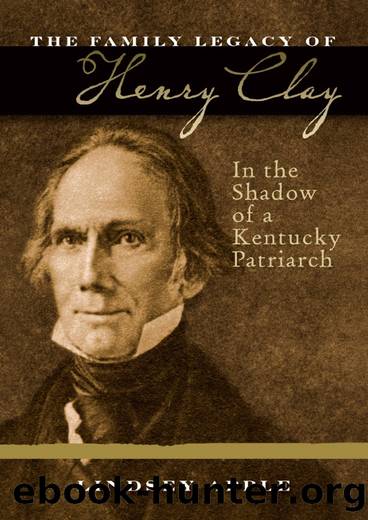The Family Legacy of Henry Clay by Lindsey Apple

Author:Lindsey Apple
Language: eng
Format: epub
Publisher: The University Press of Kentucky
Published: 2021-10-15T00:00:00+00:00
Madeline McDowell Breckinridge. Courtesy of Ashland, the Henry Clay Estate.
Yet, Madge Breckinridge remained the genteel lady Anne Firor Scott notes in her work The Southern Lady: From Pedestal to Politics. She and her kinswomen went to suffrage rallies in fashionable hats and long gloves. Madge consistently used her legacy as the great-granddaughter of Henry Clay and her social standing in the cause of suffrage. Her father had sent her to Miss Porterâs School in Connecticut, but he brought her back after one year because he did not want her to lose the values she shared with the community in which she would live. Major McDowell was proud of his daughterâs intellect, but he saw her role from the perspective of tradition. Melba Hay, Breckinridgeâs biographer, argues that she learned her sense of noblesse oblige from her father. She later adhered to the concepts of scientific philanthropy, but there remained within her thinking the sense of class superiority and social obligation learned in her youth. Many of the traditional moral values expected of women remained with her as well. She wrote from Europe that having experienced the American stage, she thought herself beyond shock until she attended a French play. Years later, suffering from her husband Deshaâs infidelity, she met the contempt of Lexington with the dignity expected of a southern lady. Hay suggests that at one point Madge may have even blamed herself to some degree for Deshaâs unfaithfulness.50
The traditional views of the Clay family reflect not only adherence to regional values but a growing defensiveness about the family name. Increasingly, family members thought Lexington and the nation sought to demean the character of the family and the contribution of Henry Clay. Each branch of the family reserved a folder or a box for newspaper and magazine stories about Henry Clay and other family members. Annie Green Clay, the daughter of Thomas H. Clay Jr., created a huge scrapbook with newspaper articles about Clay from throughout the country. Noticeably missing were the numerous negative stories about her ancestor.51
Family members became increasingly sensitive about inaccurate and unfavorable accounts. Given the harsh, politically motivated attacks on Henry and later James Clay, that branch of the family was particularly sensitive, but there was enough sensitivity to supply the entire family. Lexington had always enjoyed a good story at the expense of the Clays. Lexingtonâs fame had grown with Henry Clayâs political success. Monuments to his fame were everywhere. Sculptures and portraits adorned city hall, libraries, and universities. In more modern times, even a local McDonaldâs decorated its walls with pictures of Clay and Ashland. Like the family itself, the town seemed ready to proclaim each new family member the successor to the patriarch. His legacy to Lexington should have insulated the Clays from attack, but if anything, it made gossip worse. Despite the existence of two universities, Lexington remained intellectually a small town. Quite class conscious since frontier days, Lexingtonâs gentry were extremely competitive. Elizabeth Murphey Simpson claimed in The Enchanted Bluegrass that the gentry were preoccupied with bloodlines.
Download
This site does not store any files on its server. We only index and link to content provided by other sites. Please contact the content providers to delete copyright contents if any and email us, we'll remove relevant links or contents immediately.
Machine Learning at Scale with H2O by Gregory Keys | David Whiting(4183)
Never by Ken Follett(3791)
Harry Potter and the Goblet Of Fire by J.K. Rowling(3775)
Unfinished: A Memoir by Priyanka Chopra Jonas(3332)
Fairy Tale by Stephen King(3220)
The Man Who Died Twice by Richard Osman(2997)
Will by Will Smith(2793)
Rationality by Steven Pinker(2291)
The Dark Hours by Michael Connelly(2243)
Can't Hurt Me: Master Your Mind and Defy the Odds - Clean Edition by David Goggins(2228)
It Starts With Us (It Ends with Us #2) by Colleen Hoover(2198)
The Storyteller by Dave Grohl(2172)
The Dawn of Everything: A New History of Humanity by David Graeber & David Wengrow(2122)
Friends, Lovers, and the Big Terrible Thing by Matthew Perry(2119)
The Becoming by Nora Roberts(2088)
The Stranger in the Lifeboat by Mitch Albom(2050)
Cloud Cuckoo Land by Anthony Doerr(2035)
Einstein: His Life and Universe by Walter Isaacson(1967)
Love on the Brain by Ali Hazelwood(1965)
